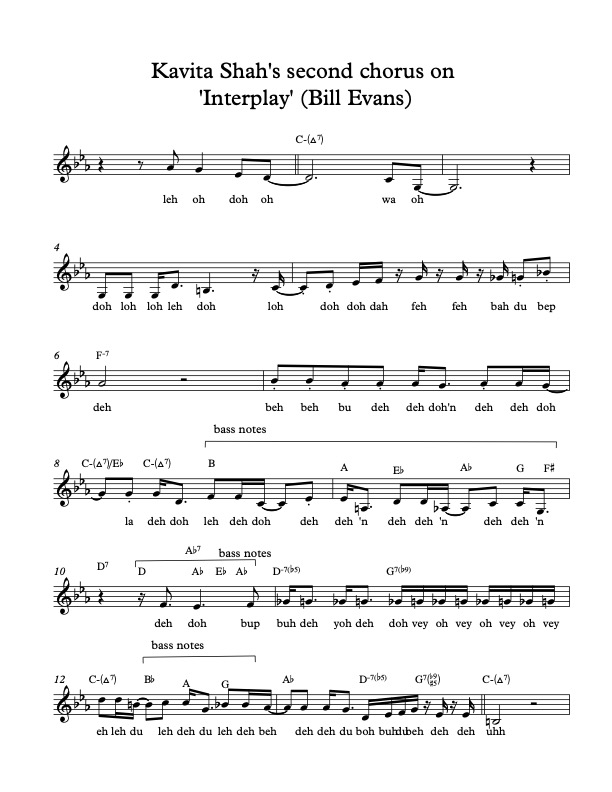Kavita Shah is a vocalist raised in Manhattan who studied jazz voice at Manhattan School of Music and incorporates her ethnographic research on Brazilian, West African, and Indian musical traditions into her original repertoire. Her recording of Interplay, a twelve bar minor blues by Bill Evans in which a contrapuntal head is followed by solos on a standard set of minor blues changes, is on her duet album of the same name with bassist Francois Moutin. Although the entire performance of this tune on the recording is remarkable, I chose to transcribe her second chorus as it lands on the rhythmic and harmonic ‘grid’ of the C minor blues progression in a way that lends itself to notation.
Appropriately enough for the title of the tune, during this chorus Shah and Moutin display some remarkable split-second responsiveness to each other’s melodic choices. While Evans’s melody is in C Aeolian mode, without a single instance of B natural in the bass or melody, just after Moutin uses a B natural in m. 2, Shah makes it a goal of her melodic phrase in m. 3, setting up a C melodic minor tonality. Just after Shah implies double-time with a single note in m. 4, Moutin double-times the bassline in m. 5. Measure 9 contains two quick reactions: after Moutin plays an A in his bassline on beat 1, Shah incorporates it into her melodic line one sixteenth note later, and after Shah sings an A flat on the ‘a’ (as in ‘2 e and a’) of beat 2, Moutin incorporates it a sixteenth note later on beat 3.
While there could be many explanations for why Shah and Moutin’s improvised parts shadow each other so closely, the number of times they react to each other’s moves, and the way they seem to take turns reacting to each other, indicates that these responses are not coincidental but rather reflect a deliberate commitment to a collaborative approach. Shah reacting to Moutin’s B natural one measure after he introduces it and Moutin responding to Shah’s double-tiiming one measure later are clearly conscious responses, but their rapid-fire reactions in m. 9 suggest to me that their level of experience with improvisation has also made them able to respond to what they hear in musical situations on an unconscious level.
The quickness with which they both react musically in this measure makes me think of the theory of ‘thin-slicing’ in psychology, which Malcolm Gladwell in his book Blink describes as ‘the ability of our unconscious to find patterns in situations and behavior based on very thin slices of experience’. This ability is often heightened by a person’s level of familiarity and expertise with certain kinds of experience. Gladwell cites the example of a firefighter who makes a split-second and lifesaving decision to evacuate his crew from a floor that collapses only moments after they leave. The firefighter, astonished by the rapidity and accuracy of his own reaction, attributes it to ESP. Gladwell then quotes research psychologist Gary Klein, who interviews the firefighter and demonstrates that he was using his experience to react to sensory information on an unconscious level, where the brain can operate faster than the conscious mind’s ability to comprehend. I would suggest that Shah and Moutin are displaying a similar level of expertise, but unlike the firefighter, they are reacting on both conscious and subconscious levels within the same twelve-bar chorus, which makes for an astonishing and inspiring performance.
